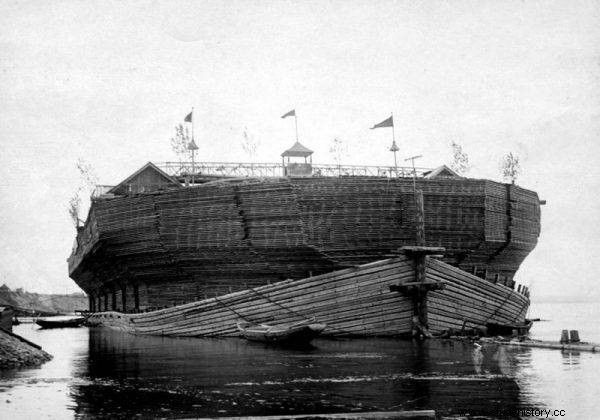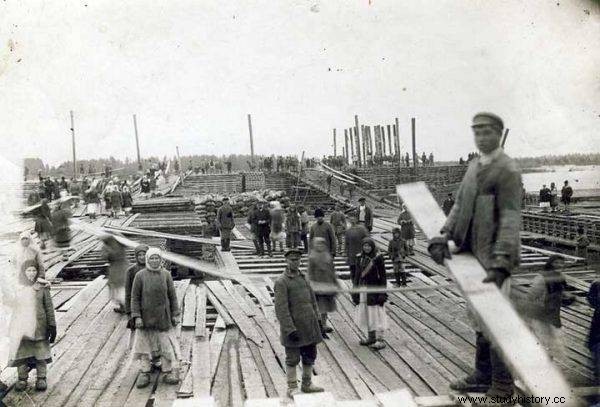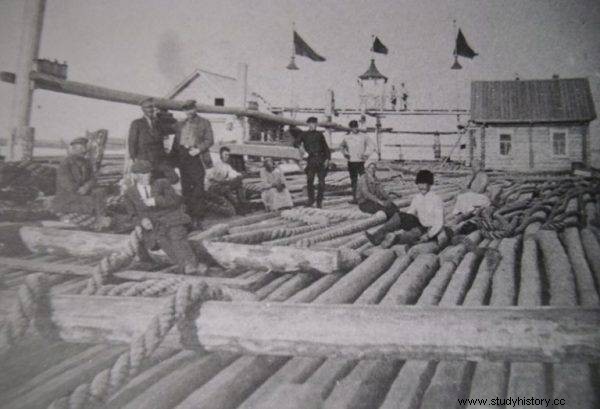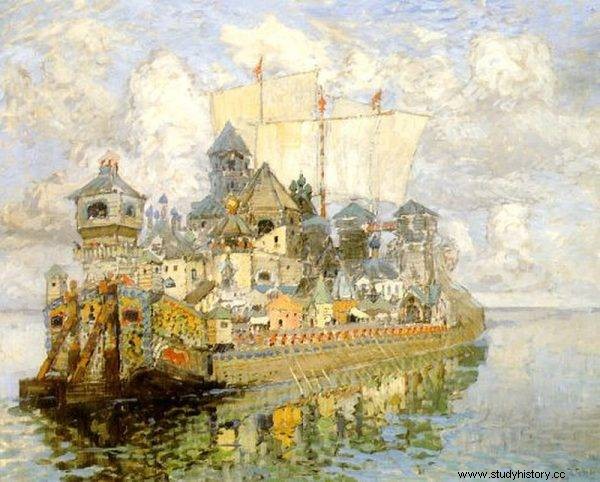The remains found in 2014 by participants of a canoe trip down the Vietluga River turned out to be fragments of a huge whitewashed - a former symbol of the Volga.
"It exceeds my wildest expectations," said Yuri Filipov, a professor at the Nizhny Novgorod State Historical and Architectural Museum. The remains, discovered in 2014 by the participants of a canoe trip down the Vietuga River, turned out to be fragments of a huge whitewashed - a former symbol of the Volga and its tributaries.
Throughout history, almost all vessels were built with the longest trouble-free service in mind. And it did not matter whether it was to take place in peaceful conditions or in the midst of a war storm. In the intention of their creators, they were to lead a busy sea life, making many happy voyages. It turns out, however, that there were also such constructions, which by definition were not allowed to return to their home ports.
Rise from rebellion
In the eighteenth and nineteenth centuries, and even until the 1920s, slowly gliding white buildings appeared on the Volga and its tributaries. Their color, however, was not a deliberate painting procedure, but the effect of the building material used. The whitewashed, as they were called, were erected from stripped raw logs and boards of coniferous trees long-lasting bright and often almost white color.

The tradition of creating these units goes back even to the 17th century
The researchers of the subject argue that the tradition of creating these units dates back even to the 17th century . He looks for their roots in the repression after the rebellion of the shooters of 1698. Many of its participants were sent by Tsar Peter I to the most distant regions of Russia. Interestingly, among these unfortunates there were also sailors and ship carpenters, who in most cases had nothing to do with the rebellion. The tsar, however, saw the guilty parties of opposing his power everywhere. In this way, a significant number of these skilled specialists ended up on the banks of great rivers, where they were supposed to assist in floating timber.
Noah's commodity ark
The shipbuilding industry was then considered extremely prestigious and very profitable. Especially with the underdeveloped road network in Russia, not to mention railroads. River transport was the fastest and cheapest way of transporting passengers and goods. Depending on the specificity of the waterways, different shapes and sizes of the units used were used. But it is the largest and longest river in Europe that allowed for the construction of bold and huge structures.
Every year wood for the construction of whitewashed was harvested from late autumn . Then the felled trees were placed on the river bank, where the shipbuilding works were started. Interestingly, the whitewashed buildings did not require any ramps, as their construction was carried out in places traditionally flooded by spring floods. Thanks to this, the unit erected on dry land stood on the water after some time - like the biblical Noah's ark . Then the only thing left was to finish it, lead it into the mainstream of the river and set off on a journey.

The felled trees were placed on the river bank, where the shipbuilding works were started.
One of a kind
The basis for the construction of the whitewash was often over 120 m long and 10 m wide hull. About 460 logs were used for its construction. The flat bottom was mostly made of fir or spruce, and the sides were made of pine. Initially no nails were used, only wedges and rigging were used . It was not until the 19th century that the logs were nailed with nails, which of course accelerated the construction process and ensured better durability. The distance between the frames did not exceed half a meter, which made the hull strength very high. It was especially important for these vessels because the way they were loaded was unusual.
The logs and boards were layered in neat rows with wide gaps between them. They were to provide quick access to the bottom of the unit in the event of leakage or other failure. In addition, about 0.5 m of free space was left between the layers, which promoted faster drying of the wood and protected it against rotting. Timber being transported did not touch the sides of the unit . The free space was filled with wedges, which were replaced with larger ones as the wood dried and contracted.
Interestingly, the loading did not end at the upper edge of the sides. Subsequent layers were placed with them protruding beyond their limits. The situation was similar with the next layers, which formed a kind of balconies widening towards the top . The resulting widenings resulted in the fact that the width of the ship at the top was much greater than at the bottom - often even 40 m.
Like an aircraft carrier
The whitewashed deck was also nothing but cargo. Usually, however, it was laid out of planks and was so large that could successfully resemble the deck of an aircraft carrier - if only then they knew what it was. There were holes in it for lifting heavy anchors (some weighed up to 1.5 tons) and tightening the ropes holding the rudder. Near the stern two huts were usually built for a crew of 15-100 people . Between their roofs there was a platform with a cockpit for the pilot - the most important person on board.

Two huts for a crew of between 15 and 100 were usually built near the stern.
The largest of the saplings were 6–7 m high, and their carrying capacity could reach 13 thousand. t. To safely lead such a colossus through the treacherous fairways of the Volga and its tributaries was an extremely difficult task. The most experienced pilots who knew all the quirks of the river and ... the unit itself were employed for the trip. The pilot was present at the construction stage, because each whitewash had a separate specification (although the design assumptions were always the same). No wonder that the pilot earned a staggering amount of 400-600 rubles for the trip that lasted several months. For comparison, regular seamen received from 30 to 40 rubles for a voyage.
Prestige above all
Controlling these peculiar cruisers was also quite a feat, especially since rowers and sails were not used. The whites were flowing with the river current, and all maneuvers were performed with a huge rudder as well as ballasts and anchors thrown on chains, respectively. The voyage of timber container ships was usually insured by several sailing boats used for surveying the bottom of the river bed, communication with land or in emergency situations. However, despite its size and specific control, the researchers of the subject emphasize the exceptional maneuverability of the whiteners, which were able to literally change course on the spot.
Although the bleached ones were by definition typical disposables , it was not spared on beautifying them. Pilot booths were very often decorated with wood carvings, and were also painted with gold paint (!). Huge and richly decorated state and trade flags were hoisted on masts erected only for this purpose. Among them, however, the flags of the owners of the vessels stood out the most. They often overshadowed others with the richness of decorations and their size. It was supposed to emphasize the wealth and prestige of the shipowners.

photo:Konstantin Gorbatov / public domain The legendary city of Kitezh was supposed to sail on the Volga on the Volga River
Nearly 3.5 thousand kilometers down the Volga the whitewashed reached their destination, which was usually Saratov, Tsaritsyn (today's Volgograd) or Astrakhan. There, the giants of the Volga region were dismantled to the last splinter, and the wood was sold and further processed. Deck huts, on the other hand, found new tenants as ready-made houses. Most of the materials used in the construction, such as ropes, chains or nails, generated income.
Only smaller specimens of whitewashed a longer life, which, usually loaded with fish and other supplies for builders, returned up the river towed by boats or burats - people who pull barges along the shore. But there, too, they shared the fate of their bigger cousins. Maintaining whitewash for more than one season was simply unprofitable - like unsecured wood, it simply rotted. It was cheaper to build new ones (!).
Remaining legend
The popularity of the whitewater culminated in the mid-nineteenth century with the increasing use of steamboats. It is estimated that during this period there were up to 500 steamers on the Lower Volga. And since they originally only burned wood, it is not hard to imagine how enormous this fuel was needed by the entire fleet. It was only with the switch to oil that the demand for firewood decreased. Nevertheless, as late as the end of the 19th century, up to 150 whitewashed a year were built. However, with the development of railways and road transport, this number began to shrink rapidly and disappeared in the 1920s.
There were attempts to revive the romantic legend of the majestic Volga colossi in the Soviet Union at the end of the 1930s. Moreover, the use of whitewashed in the post-war reconstruction of Stalingrad was even sought. Ultimately, however, their construction turned out to be unprofitable, and besides, they required exceptional skills - and these, unfortunately, were already missing.
Bibliography
- Bazylow L., Wieczorkiewicz P., History of Russia , Wrocław 2005.
- Писаревский А.А., Белянный сплав леса, Москва 1933.
- Piwoński J., Unusual ships , Warsaw 1986.
- Поздняков A., Уникальное судно найдено в Ветлуг е, nn.mk.ru [access:1/9/2022].
- Serczyk W.A., Peter the Great , Wrocław 2003.
- Shpakovsky V., Belyana:almost ready aircraft carrier for the Volga! , en.topwar.ru [access:10/01/2022].
- Верховский В.Н., Беляна , Санкт-Петербург 1911.
